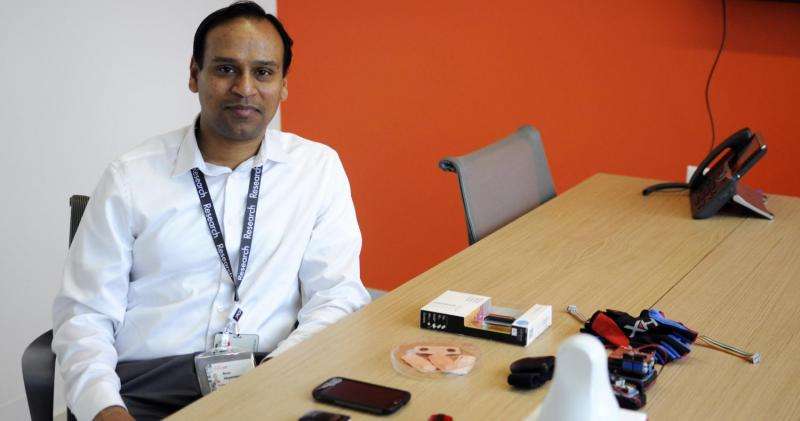Credit: Northwestern University
From Fitbit trackers to sticky patches, Northwestern scientists and clinicians are using wearable technology to gather a wealth of novel information about patients and to devise innovative ways to treat and prevent disease.
Bonnie Spring, PhD, Director of the Center for Behavior and Health in the Institute for Public Health and Medicine (IPHAM), predicts the use of wearables in research will explode in the near future. Spring and her team have used tracking technology for years, since "the age when palm pilots were cutting edge." Now, nearly 15 years later, Spring is leading several trials using wearable devices and mobile applications to track behaviors.
In the Sense2stop study, Spring and her team are using wearable sensors to identify when people are most at risk to indulge in a bad habit, such as smoking.
"This is fairly cutting-edge, because we are capitalizing on the fact that people don't need our help all of the time — they just need it when they are at risk. The problem is, they don't know when that is, and neither do we," says Spring, who is also a professor of Preventive Medicine and Psychiatry and Behavioral Sciences.
Spring and her collaborators are also currently testing the impact of a mindfulness intervention during times of stress. Subjects wear a chest strap that collects data on the patient's respiration and heart rate. When the patient shows physiological signs of stress, the sensor detects it in real time, and sends an intervention to the person's mobile phone. In addition to tracking stress alone, the team is also testing a suite of sensors to track stress signals related to smoking and overeating.
"We're learning what the signals look like that predict when they are about to do those behaviors," Spring says. "We're trying to get people out of their stress state."
Additionally, these trackers can allow clinicians to develop new treatment procedures, by giving scientists the tools to quickly learn how a person responds to and adapts to treatments.
"You can see early on whether or not something is working. We will be able to use the sensor technologies to get an early warning on how people are doing," Spring says.
In another current trial focused on weight loss, Spring and her group are using a "stepped care" model, a way to deliver and monitor tiered treatments. A patient steps up to the next treatment tier as determined by the health professional. Patients in the study are given scales with Wi-Fi that tracks their weight loss progress. Instead of having to wait months to know if the treatment is working, care providers can know within two weeks whether the patient is responding.
In addition to their use in prevention, wearable devices are also being used in rehabilitation. Christine Pellegrini, PhD, adjunct assistant professor of Preventive Medicine, currently uses Fitbit activity trackers in a pilot study to track physical activity levels in patients who have had knee replacement surgery.
Pellegrini and her team are following two groups of patients for four months within the first year after their surgery. One group of patients will receive a Fitbit alone, while the other group will receive Fitbits for themselves and a buddy. Pellegrini hopes to learn if simply providing a wearable device will increase physical activity, as well as determining whether having a friend, spouse or coworker connected with them through the activity tracker app motivates patients to be even more active.
The activity trackers are potentially valuable for knee replacement patients, because though they to physical therapy after surgery, therapy alone may not provide the necessary motivation to lead a healthy, active lifestyle.
"We will be able to get an idea of overall physical activity and come up with potential recommendations for orthopedic surgeons and physical therapists. With the buddy system, we are looking at different social support constructs. Ultimately, we are looking to explore different options. Currently, there isn't much on lifestyle and physical activity guidelines on a daily basis for these patients," Pellegrini said.
At the Shirley Ryan AbilityLab in the Center for Bionic Medicine, Arun Jayaraman, PhD, associate professor of Physical Medicine and Rehabilitation, uses wearable sensors and novel machine learning techniques for outcomes research in patients with physical disabilities.
Also a professor of Medical Social Sciences and Physical Therapy and Human Movement Sciences, Jayaraman is currently conducting more than 20 studies at the lab, from gloves that measure the mechanics of wheelchair use for shoulder injury research to next-generation prostheses with advanced technology to prevent falls in amputees.
In collaboration with John Rogers, PhD, the Louis Simpson and Kimberly Querrey Professor of Materials Science and Engineering, Biomedical Engineering and Neurological Surgery, Jayaraman is testing an adhesive skin device for an inpatient stroke study that monitors sleep, heart rate, stress, activity and more.
"Patient monitoring allows clinicians to know what happens when a patient gets a medication or goes to physical therapy," Jayaraman says. "We can use the data from the monitors to quantify a patient's medication or their surgical or therapeutic intervention."
A large part of his team's time is spent on customizing monitors to different patient populations. Jayaraman stresses the limitations of commercial sensor technology, which is usually calculated to pick up simple patterns in healthy, young individuals.
"It takes a lot of time and work to develop advanced machine learning techniques," Jayaraman says. "There is a lot of over- or under-prediction of performance in devices such as Fitbits, and for the average person, an approximate calculation is okay, but for patients where physicians may want to change a drug dosage, therapy plan or gauge whether surgery is needed, it's important to have accurate and precise data."
Jayaraman envisions a future where wearables will "talk" to robots to assist or protect patients. With newly-developed sensors becoming ever-smaller, Jayaraman predicts they will eventually become non-contact sensors, which in the future would be able to sweep a room and pick up detailed data on all of the people moving within.
Provided by Northwestern University























